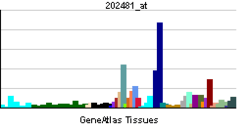DHRS3
| View/Edit Human | View/Edit Mouse |
Short-chain dehydrogenase/reductase 3 is an enzyme that in humans is encoded by the DHRS3 gene.[3][4][5][6]
References
- ↑ "Human PubMed Reference:".
- ↑ "Mouse PubMed Reference:".
- ↑ Haeseleer F, Huang J, Lebioda L, Saari JC, Palczewski K (Sep 1998). "Molecular characterization of a novel short-chain dehydrogenase/reductase that reduces all-trans-retinal". J Biol Chem. 273 (34): 21790–9. doi:10.1074/jbc.273.34.21790. PMID 9705317.
- ↑ Haeseleer F, Jang GF, Imanishi Y, Driessen CA, Matsumura M, Nelson PS, Palczewski K (Nov 2002). "Dual-substrate Specificity Short Chain Retinol Dehydrogenases from the Vertebrate Retina". J Biol Chem. 277 (47): 45537–46. doi:10.1074/jbc.M208882200. PMC 1435693
 . PMID 12226107.
. PMID 12226107. - ↑ Persson B, Kallberg Y, Bray JE, Bruford E, Dellaporta SL, Favia AD, Duarte RG, Jornvall H, Kavanagh KL, Kedishvili N, Kisiela M, Maser E, Mindnich R, Orchard S, Penning TM, Thornton JM, Adamski J, Oppermann U (Feb 2009). "The SDR (Short-Chain Dehydrogenase/Reductase and Related Enzymes) Nomenclature Initiative". Chem Biol Interact. 178 (1–3): 94–8. doi:10.1016/j.cbi.2008.10.040. PMC 2896744
 . PMID 19027726.
. PMID 19027726. - ↑ "Entrez Gene: DHRS3 dehydrogenase/reductase (SDR family) member 3".
Further reading
- Maruyama K, Sugano S (1994). "Oligo-capping: a simple method to replace the cap structure of eukaryotic mRNAs with oligoribonucleotides". Gene. 138 (1–2): 171–4. doi:10.1016/0378-1119(94)90802-8. PMID 8125298.
- Suzuki Y, Yoshitomo-Nakagawa K, Maruyama K, et al. (1997). "Construction and characterization of a full length-enriched and a 5'-end-enriched cDNA library". Gene. 200 (1–2): 149–56. doi:10.1016/S0378-1119(97)00411-3. PMID 9373149.
- Cerignoli F, Guo X, Cardinali B, et al. (2002). "retSDR1, a short-chain retinol dehydrogenase/reductase, is retinoic acid-inducible and frequently deleted in human neuroblastoma cell lines". Cancer Res. 62 (4): 1196–204. PMID 11861404.
- Strausberg RL, Feingold EA, Grouse LH, et al. (2003). "Generation and initial analysis of more than 15,000 full-length human and mouse cDNA sequences". Proc. Natl. Acad. Sci. U.S.A. 99 (26): 16899–903. doi:10.1073/pnas.242603899. PMC 139241
 . PMID 12477932.
. PMID 12477932. - Clark HF, Gurney AL, Abaya E, et al. (2003). "The Secreted Protein Discovery Initiative (SPDI), a Large-Scale Effort to Identify Novel Human Secreted and Transmembrane Proteins: A Bioinformatics Assessment". Genome Res. 13 (10): 2265–70. doi:10.1101/gr.1293003. PMC 403697
 . PMID 12975309.
. PMID 12975309. - Gerhard DS, Wagner L, Feingold EA, et al. (2004). "The Status, Quality, and Expansion of the NIH Full-Length cDNA Project: The Mammalian Gene Collection (MGC)". Genome Res. 14 (10B): 2121–7. doi:10.1101/gr.2596504. PMC 528928
 . PMID 15489334.
. PMID 15489334. - Gregory SG, Barlow KF, McLay KE, et al. (2006). "The DNA sequence and biological annotation of human chromosome 1". Nature. 441 (7091): 315–21. doi:10.1038/nature04727. PMID 16710414.
- Roni V, Carpio R, Wissinger B (2007). "Mapping of transcription start sites of human retina expressed genes". BMC Genomics. 8: 42. doi:10.1186/1471-2164-8-42. PMC 1802077
 . PMID 17286855.
. PMID 17286855.
This article is issued from Wikipedia - version of the 6/6/2016. The text is available under the Creative Commons Attribution/Share Alike but additional terms may apply for the media files.
